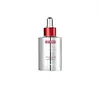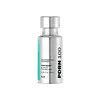What's inside
What's inside
 Key Ingredients
Key Ingredients

 Benefits
Benefits

 Concerns
Concerns

 Ingredients Side-by-side
Ingredients Side-by-side

Water
Skin ConditioningGlycerin
HumectantButylene Glycol
HumectantNiacinamide
SmoothingSodium Lactate
Buffering1,2-Hexanediol
Skin ConditioningGellan Gum
PEG-60 Hydrogenated Castor Oil
EmulsifyingEthylhexylglycerin
Skin ConditioningAdenosine
Skin ConditioningDisodium EDTA
Actinidia Chinensis Fruit Extract
EmollientEucalyptus Alba Leaf Extract
Skin ConditioningCentella Asiatica Extract
CleansingGold
Cosmetic ColorantPolygonum Cuspidatum Root Extract
AntioxidantPropanediol
SolventGlycyrrhiza Glabra Root Extract
BleachingCamellia Sinensis Leaf Extract
AntimicrobialSodium Hyaluronate Crosspolymer
HumectantRosmarinus Officinalis Leaf Extract
AntimicrobialFructan
Skin ConditioningChamomilla Recutita Extract
Skin ConditioningSodium Hyaluronate
HumectantHydrolyzed Glycosaminoglycans
HumectantGlycine
BufferingCaprylyl Glycol
EmollientPolysorbate 80
EmulsifyingSerine
MaskingGlutamic Acid
HumectantHydrolyzed Elastin
EmollientEctoin
Skin ConditioningHydrogenated Polyisobutene
EmollientBenzyl Glycol
SolventAspartic Acid
MaskingLeucine
Skin ConditioningOryza Sativa Extract
AbsorbentAstaxanthin
Skin ConditioningHydrolyzed Hyaluronic Acid
HumectantAlanine
MaskingLysine
Skin ConditioningArginine
MaskingTyrosine
MaskingPhenylalanine
MaskingValine
MaskingThreonine
Proline
Skin ConditioningIsoleucine
Skin ConditioningHistidine
HumectantMethionine
Skin ConditioningCysteine
AntioxidantPalmitoyl Tetrapeptide-7
Skin ConditioningHydrolyzed Sodium Hyaluronate
Skin ConditioningHydrolyzed Collagen
EmollientAcetyl Octapeptide-3
HumectantTripeptide-1
Skin ConditioningPalmitoyl Tripeptide-1
Skin ConditioningPalmitoyl Pentapeptide-4
Skin ConditioningCopper Tripeptide-1
Skin ConditioningAcetyl Hexapeptide-8
HumectantSodium Benzoate
MaskingSodium Acetylated Hyaluronate
HumectantHexapeptide-9
Skin ConditioningHydroxypropyltrimonium Hyaluronate
Hyaluronic Acid
HumectantDimethylsilanol Hyaluronate
HumectantNonapeptide-1
Skin ConditioningPentylene Glycol
Skin ConditioningHair Extract
Potassium Hyaluronate
Skin ConditioningTocopherol
AntioxidantAlcohol Denat.
AntimicrobialParfum
MaskingWater, Glycerin, Butylene Glycol, Niacinamide, Sodium Lactate, 1,2-Hexanediol, Gellan Gum, PEG-60 Hydrogenated Castor Oil, Ethylhexylglycerin, Adenosine, Disodium EDTA, Actinidia Chinensis Fruit Extract, Eucalyptus Alba Leaf Extract, Centella Asiatica Extract, Gold, Polygonum Cuspidatum Root Extract, Propanediol, Glycyrrhiza Glabra Root Extract, Camellia Sinensis Leaf Extract, Sodium Hyaluronate Crosspolymer, Rosmarinus Officinalis Leaf Extract, Fructan, Chamomilla Recutita Extract, Sodium Hyaluronate, Hydrolyzed Glycosaminoglycans, Glycine, Caprylyl Glycol, Polysorbate 80, Serine, Glutamic Acid, Hydrolyzed Elastin, Ectoin, Hydrogenated Polyisobutene, Benzyl Glycol, Aspartic Acid, Leucine, Oryza Sativa Extract, Astaxanthin, Hydrolyzed Hyaluronic Acid, Alanine, Lysine, Arginine, Tyrosine, Phenylalanine, Valine, Threonine, Proline, Isoleucine, Histidine, Methionine, Cysteine, Palmitoyl Tetrapeptide-7, Hydrolyzed Sodium Hyaluronate, Hydrolyzed Collagen, Acetyl Octapeptide-3, Tripeptide-1, Palmitoyl Tripeptide-1, Palmitoyl Pentapeptide-4, Copper Tripeptide-1, Acetyl Hexapeptide-8, Sodium Benzoate, Sodium Acetylated Hyaluronate, Hexapeptide-9, Hydroxypropyltrimonium Hyaluronate, Hyaluronic Acid, Dimethylsilanol Hyaluronate, Nonapeptide-1, Pentylene Glycol, Hair Extract, Potassium Hyaluronate, Tocopherol, Alcohol Denat., Parfum
Water
Skin ConditioningIsopropyl Myristate
EmollientPanax Ginseng Root Extract
EmollientCaprylic/Capric Triglyceride
MaskingCetyl Ethylhexanoate
EmollientGlycerin
HumectantPropanediol
SolventNiacinamide
SmoothingPolyglyceryl-2 Dipolyhydroxystearate
Skin ConditioningPEG-30 Dipolyhydroxystearate
EmulsifyingPolyglyceryl-3 Diisostearate
Emulsifying1,2-Hexanediol
Skin ConditioningTocopherol
AntioxidantHydroxyacetophenone
AntioxidantHelianthus Annuus Seed Oil
EmollientAcrylates/C10-30 Alkyl Acrylate Crosspolymer
Emulsion StabilisingArginine
MaskingAdenosine
Skin ConditioningCeramide NP
Skin ConditioningAdansonia Digitata Seed Oil
EmollientDisodium EDTA
Hydrogenated Lecithin
EmulsifyingAllantoin
Skin ConditioningSqualane
EmollientPanthenol
Skin ConditioningPolyglucuronic Acid
Skin ConditioningCeramide Ns
Skin ConditioningCeramide As
Skin ConditioningCeramide EOP
Skin ConditioningCeramide AP
Skin ConditioningSodium Dna
Skin ConditioningWater, Isopropyl Myristate, Panax Ginseng Root Extract, Caprylic/Capric Triglyceride, Cetyl Ethylhexanoate, Glycerin, Propanediol, Niacinamide, Polyglyceryl-2 Dipolyhydroxystearate, PEG-30 Dipolyhydroxystearate, Polyglyceryl-3 Diisostearate, 1,2-Hexanediol, Tocopherol, Hydroxyacetophenone, Helianthus Annuus Seed Oil, Acrylates/C10-30 Alkyl Acrylate Crosspolymer, Arginine, Adenosine, Ceramide NP, Adansonia Digitata Seed Oil, Disodium EDTA, Hydrogenated Lecithin, Allantoin, Squalane, Panthenol, Polyglucuronic Acid, Ceramide Ns, Ceramide As, Ceramide EOP, Ceramide AP, Sodium Dna
 Reviews
Reviews

Ingredients Explained
These ingredients are found in both products.
Ingredients higher up in an ingredient list are typically present in a larger amount.
1,2-Hexanediol is a synthetic liquid and another multi-functional powerhouse.
It is a:
- Humectant, drawing moisture into the skin
- Emollient, helping to soften skin
- Solvent, dispersing and stabilizing formulas
- Preservative booster, enhancing the antimicrobial activity of other preservatives
Adenosine is in every living organism. It is one of four components in nucleic acids that helps store our DNA.
Adenosine has many benefits when used. These benefits include hydrating the skin, smoothing skin, and reducing wrinkles. Once applied, adenosine increases collagen production. It also helps with improving firmness and tissue repair.
Studies have found adenosine may also help with wound healing.
In skincare products, Adenosine is usually derived from yeast.
Learn more about AdenosineArginine is an amino acid that is important for human development. Your body uses is it to produce hair keratin and skin collagen.
As a cosmetic ingredient, Arginine has antioxidant properties and can also help repair damaged skin. This ingredient is derived either synthetically or from animals.
Arginine isn't fungal acne safe when used in the presence of other lipids (fats, fatty acids, oils, esters, etc). Oils and fats occur naturally within the skin, so take caution when using Arginine if you're prone to fungal acne.
Learn more about ArginineDisodium EDTA plays a role in making products more stable by aiding other preservatives.
It is a chelating agent, meaning it neutralizes metal ions that may be found in a product.
Disodium EDTA is a salt of edetic acid and is found to be safe in cosmetic ingredients.
Learn more about Disodium EDTAGlycerin is already naturally found in your skin. It helps moisturize and protect your skin.
A study from 2016 found glycerin to be more effective as a humectant than AHAs and hyaluronic acid.
As a humectant, it helps the skin stay hydrated by pulling moisture to your skin. The low molecular weight of glycerin allows it to pull moisture into the deeper layers of your skin.
Hydrated skin improves your skin barrier; Your skin barrier helps protect against irritants and bacteria.
Glycerin has also been found to have antimicrobial and antiviral properties. Due to these properties, glycerin is often used in wound and burn treatments.
In cosmetics, glycerin is usually derived from plants such as soybean or palm. However, it can also be sourced from animals, such as tallow or animal fat.
This ingredient is organic, colorless, odorless, and non-toxic.
Glycerin is the name for this ingredient in American English. British English uses Glycerol/Glycerine.
Learn more about GlycerinNiacinamide is a multitasking form of vitamin B3 that strengthens the skin barrier, reduces pores and dark spots, regulates oil, and improves signs of aging.
And the best part? It's gentle and well-tolerated by most skin types, including sensitive and reactive skin.
You might have heard of "niacin flush", or the reddening of skin that causes itchiness. Niacinamide has not been found to cause this.
In very rare cases, some individuals may not be able to tolerate niacinamide at all or experience an allergic reaction to it.
If you are experiencing flaking, irritation, and dryness with this ingredient, be sure to double check all your products as this ingredient can be found in all categories of skincare.
When incorporating niacinamide into your routine, look out for concentration amounts. Typically, 5% niacinamide provides benefits such as fading dark spots. However, if you have sensitive skin, it is better to begin with a smaller concentration.
When you apply niacinamide to your skin, your body converts it into nicotinamide adenine dinucleotide (NAD). NAD is an essential coenzyme that is already found in your cells as "fuel" and powers countless biological processes.
In your skin, NAD helps repair cell damage, produce new healthy cells, support collagen production, strengthen the skin barrier, and fight environmental stressors (like UV and pollution).
Our natural NAD levels start to decline with age, leading to slower skin repair, visible aging, and a weaker skin barrier. By providing your skin niacinamide, you're recharging your skin's NAD levels. This leads to stronger, healthier, and younger looking skin.
Another name for vitamin B3 is nicotinamide. This vitamin is water-soluble and our bodies don't store it. We obtain Vitamin B3 from either food or skincare. Meat, fish, wheat, yeast, and leafy greens contain vitamin B3.
The type of niacinamide used in skincare is synthetically created.
Learn more about NiacinamidePropanediol is an all-star ingredient. It softens, hydrates, and smooths the skin.
It’s often used to:
Propanediol is not likely to cause sensitivity and considered safe to use. It is derived from corn or petroleum with a clear color and no scent.
Learn more about PropanediolTocopherol (also known as Vitamin E) is a common antioxidant used to help protect the skin from free-radicals and strengthen the skin barrier. It's also fat soluble - this means our skin is great at absorbing it.
Vitamin E also helps keep your natural skin lipids healthy. Your lipid skin barrier naturally consists of lipids, ceramides, and fatty acids. Vitamin E offers extra protection for your skin’s lipid barrier, keeping your skin healthy and nourished.
Another benefit is a bit of UV protection. Vitamin E helps reduce the damage caused by UVB rays. (It should not replace your sunscreen). Combining it with Vitamin C can decrease sunburned cells and hyperpigmentation after UV exposure.
You might have noticed Vitamin E + C often paired together. This is because it is great at stabilizing Vitamin C. Using the two together helps increase the effectiveness of both ingredients.
There are often claims that Vitamin E can reduce/prevent scarring, but these claims haven't been confirmed by scientific research.
Learn more about TocopherolWater. It's the most common cosmetic ingredient of all. You'll usually see it at the top of ingredient lists, meaning that it makes up the largest part of the product.
So why is it so popular? Water most often acts as a solvent - this means that it helps dissolve other ingredients into the formulation.
You'll also recognize water as that liquid we all need to stay alive. If you see this, drink a glass of water. Stay hydrated!
Learn more about Water